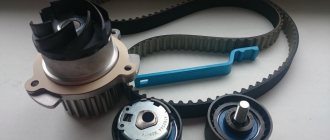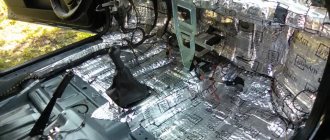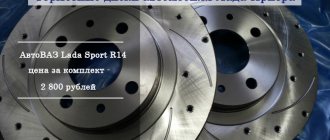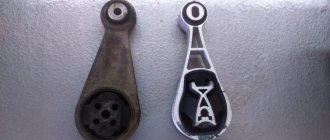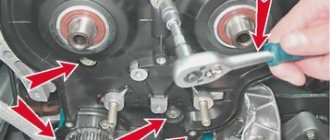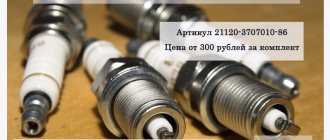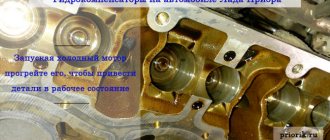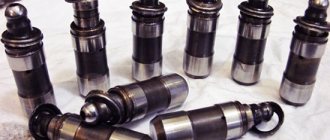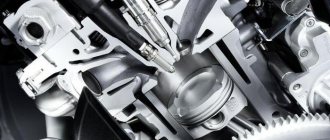Compensators are needed for automatic valve adjustment; if they were not there, it would be necessary to adjust the valves every 10 thousand, as on 2109. On the Prior, hydraulic compensators knock under different circumstances - and this is not always a malfunction.
They have a special knock, so experienced car enthusiasts will recognize it almost immediately. A knock that comes from the engine of a Priora car is not a very good sign that should alert you. Each car needs to be approached differently. Therefore, when hydraulic compensators on a Priora knock, make proper preparations for repairs - you need to find out what is the reason for what is happening and how you can eliminate it by correcting the situation. In this article, we have collected for you the main signs: why these parts make noise, whether the car is cold or hot.
Important: Even if the new hydraulic lifters are knocking, this is not a reason to prepare for the worst outcome - it sounds strange, but it is true. This is a VAZ, gentlemen, and everything can happen on it.
These parts have 16 valves on the Priora. (if taken as a complete set) they are not so little. The price starts from 4000 rubles and above. Replacing hydraulic compensators is labor-intensive and I don’t recommend getting into the engine yourself without experience. At a service station, such work for a Priora car will cost from 5,000 rubles and more.
The picture shows the valve seat - and in the middle there is a compensator
Hydraulic compensator operating principle and design
The hydraulic compensator is a small cylinder, inside of which there is a spring and a pair of even smaller cylinders - plungers, as well as a check valve. The operating principle of the engine is such that it achieves maximum efficiency when the chamber contains a “clean” mixture - exclusively fuel and air.
When gases remain there after one cycle, the mixture becomes increasingly less pure and the engine produces less power. In order for gases to leave the chamber in time, the operation of the valves must be harmonious. There are hydraulics for this - they constantly adjust the position of the valves. And oil enhances their work and helps fight friction.
The oil enters a small gap under the plunger, presses on it, and after that the pusher exerts force on the valve. When at rest (during the so-called “break” when the cam moves), the pusher is constantly in contact with the camshaft cam, which is ready at any moment to move it down so that the valves open even more.
On Priora, the knocking sound of hydraulic compensators appears when the trajectory of their movement changes. That is, when they have to change the position of the valve, they move “crookedly”, and their efficiency approaches zero. There can be several reasons for problems with hydraulics and valves. Diagnostics may lead to the discovery of other faults.
What is the problem
A hydraulic compensator is an engine mechanism that regulates the operation of valves. This small part saves fuel, reduces engine sounds, extends the life of other parts, and increases engine power. The device is complexly designed; when dirt gets into the engine cylinder, it becomes clogged, and cheap, low-quality oil disables it.
The malfunction of hydraulic compensators can be determined by the following criteria:
- Engine knocking that does not decrease when the car warms up.
- Reduced power.
Replacement of this mechanism occurs, most often, when the car has a hundred-kilometer mileage. This condition guarantees wear of the part, which may be exceeded.
Causes of the problem:
- Use of low quality spare parts.
- Particles formed by abrasive devices getting into the hydraulic compensator.
- Clogging of channels when using low-quality oil or filter failure.
- Incorrect oil filling.
Replacing hydraulic compensators on a Priora (16 valves)
For work, prepare the following tools:
- flat-head, Phillips-head screwdriver;
- socket wrenches;
- You may need a cylinder head gasket; replacing it will allow you to be safe from the fact that the spark plugs may flood the spark plugs with oil;
- sealant;
- magnet - for convenience.
Replace expansion joints on a Priora car according to the instructions:
- Stop the car with the handbrake. Lift the hood.
- Loosen the clamp securing the crankcase ventilation hose (main circuit).
- Disconnect the hose from the cylinder head fitting. Cover the fitting with rags to prevent any objects from getting inside.
- Remove the bracket for the wires of the injectors and ignition coils, having first unscrewed the bolts with the “10” head.
- Disconnect the throttle assembly wiring harness from the cylinder head, having first removed the fastenings with the same head.
- Let's move on to the cylinder block cover. All fifteen screws will have to be unscrewed. To do this, use the E-8 head. Please note that it is additionally secured with sealant.
- Therefore, use a plastic screwdriver to carefully pry the cover in places where there are visible gaps, and then lift it. At this point, evaluate the camshaft lobe wear. It should not be covered with chips or other signs of mechanical damage.
- Now you can check the faulty hydraulic compensators. Avoid damaging the valves of the gas distribution mechanism; handle them carefully.
- Remove the faulty hydraulics with a magnet and put new ones in their place, securing them in a level position.
- Along the way, you should inspect all parts, assessing the degree of wear. This will help to find the reasons for the wear of the hydraulics or the consequence - something that has worn out faster due to their improper operation.
- Replace sequentially. Do not forget to coat the cylinder head cover with sealant to ensure maximum adherence to the body.
- Reassemble the components in reverse order, check the operation of the new hydraulic tappets by starting the engine.
How hydraulic compensators knock: video
Where to order the service
The hydraulic compensator prevents parts from breaking when the engine heats up (they need additional space when expanding). A problem in the functioning of the hydraulic compensator inevitably leads to disruption of the entire automotive system. Proper care of the engine mechanism will help avoid these types of problems.
High-precision equipment will allow you to determine the malfunction of the mechanism in almost a few minutes. Car services provide the necessary documentation and warranty for the new part. If you have certain knowledge and skills, you can replace the part yourself; in the absence of such, you need to entrust your car to experienced specialists working in car repair shops.
Price list for car diagnostics
Price list for oil change
Cost (passenger cars), rub.*
Cost (jeeps, minivans), rub.*
How to identify a faulty hydraulic compensator
Before work, analyze the wear of all pushers, otherwise the case where someone changed the working compensators will repeat. The search for knocking hydraulic compensators of Priora 16 valves involves conducting several experiments or tests. It is basically calculated that Priora hydraulic pushers operate for 100 thousand kilometers.
These parts may rattle when starting a cold engine, and then continue to make noise even when the engine warms up. Knowing about this malfunction, follow these steps to identify faulty Priora hydraulic pushers:
- Check the main valve ball valve. If it is worn out, then nothing can be done - the hydraulic valve will have to be changed and a new part installed in its place.
- The internal cavity of the pusher is contaminated with used grease or oil. If the cases are not critical, you can wash the hydraulics and then coat everything inside with a good oil composition.
- A couple of plungers are worn out - these are two small cylinders. The part cannot be repaired, so it will also have to be replaced.
These signs appear when the hydraulic valves knock while the engine is cold, as well as after it has warmed up, but they quiet down at high speeds. There is another way that will help identify faulty hydraulic pushers. It touches the spring - it is responsible for ensuring that the small parts return to their place whenever the valve needs to be returned back, closing the hole.
In order to see how the HA springs work, press each small part through a soft cloth. At the same time, try to place your finger so that it completely covers its upper part. A well-functioning hydraulic compensator should return when pressed. If it remains at the bottom, this means that the spring no longer works, and it’s time to change the part.
By the way, let’s talk about why Priora hydraulics can knock after repair work:
- If new parts make a sound, they are still falling into place - after a couple of engine starts this sound will not be there.
- If the knocking noise appears after changing the oil, the reason is poor-quality oil or a bad/worn out filter.
- Finally, after the car has been left alone for a long time, this piercing sound may also appear. Over time it will disappear. It's just that the oil has drained from the working chambers, and they need to be filled before starting everyday operation without knocking, as well as other signs of malfunctions that can be scary.
Knocks when the engine is cold, what to do
Please note that by starting a cold engine, you are subjecting it to a significant test. This does not mean at all that you cannot run it in frosty weather. It’s just that all the insides harden, the movements of parts are constrained, even “wooden”. They need to warm up in order to return to normal - then the gaps and other parameters will return to operating parameters.
Realizing the severity of the work that the engine does in the cold, we can talk in detail about the reasons why the hydraulic pushers of a cold sixteen-valve Priora engine knock:
- The engine oil life is coming to an end. The oil is of poor quality. The oil is contaminated with engine operating products.
- The viscosity of the engine oil is not suitable for the engine. If it is too soft, the hydraulics will literally “break out” of their positions, which will damage their springs.
- If the oil is too thick, the hydraulic boosters will physically be unable to push the valve.
- The oil system is clogged. If the cross-section through which the valve passes is reduced, the pressure inside the hydraulic tappet decreases and it produces less power during operation.
- The main oil line does not support high pressure. This can be recognized by the burning light indicating the oil level on the dashboard.
- The plunger inside the main valve is jammed. This can happen due to carbon deposits accumulated inside.
- The plunger is worn out. If the check valve leaks, there can be no talk of any high pressure that the hydraulic fluid exerts on the valve.
The knock does not go away or appears on a hot engine
When the engine temperature has gradually risen to operating temperature, the knocking noise may remain. On the contrary, it can suddenly appear. The cause could be any problem typical of knocking on a cold Priora engine. But due to the specifics, two more reasons can be named that cause the knocking of hydraulic pushers in warm Priora engines:
- High or low oil level. When there is too much oil, it doesn't provide room to work. If it is too small, there will not be enough pressure to push the valve.
- The hydraulic wells have expanded due to an overheated engine. Small parts will “walk” in them, and then even go down with a figure eight. Because of this, all the force that they could exert on the valve will be extinguished. Cool down the engine.
Types and cost of services
The service is provided for cars of different models. The cost of compensators and gas distribution mechanism components varies for cars (a part for a Lada Priora car costs 2200-2300 rubles ). Replacing the device is inevitable; the time when this process needs to be carried out will depend on the operating conditions of the vehicle. Car owners notice that the process of replacing the part is not as difficult as the subsequent fixation of the camshaft. The degree of wear of the hydraulic compensator is determined by squeezing it with your fingers. If this can be done, then the compensator is really worth replacing. It is better to carry out dismantling and installation in a car service center.
Replacement of hydraulic compensators for domestic cars starts from 2000 rubles . For foreign cars (belt) the price of the service will be 3,200 rubles , foreign cars (chain) – 7,000 rubles . When replacing the hydraulic compensator of an SUV, the price of the service will be from 6 thousand rubles.
For a 2011 Opel Astra (technical parameters: engine capacity 1.4 liters, 140 horsepower) with a disassembled engine, the service can cost 2 thousand rubles, and they will simply replace the part and return the car disassembled. A full range of work (engine repair) with engine disassembly can cost 18 thousand rubles . Another car service offers to pay 8,000 rubles .
Replacing one compensator for a 1999 Toyota Corona Premio (design characteristics: engine capacity 1.8 liters, power 115 horsepower) can cost approximately 8 thousand rubles.
Approximate price of hydraulic compensators
Unlike foreign-made cars, parts for the VAZ-2112 are affordable. In most auto parts stores for domestic cars you can find a set of hydraulic compensators for a sixteen-valve engine at a low price - about two thousand rubles. Before purchasing, carefully examine each pusher to avoid purchasing a defective part.
Among manufacturers of spare parts for VAZ-2112 engines, the INA brand occupies a leading position, but it is very often counterfeited. In order to make the right choice, watch a video in advance about the features of branded hydraulic pushers. Pay close attention to how much a set of pushers costs, since a high-quality spare part cannot be cheap.
The result of the work
Having completed the installation work, we check the operation of the engine. Immediately after starting, the engine may work, making extraneous sounds in the form of clattering or tapping. They indicate that the hydraulic compensators need to be pumped, i.e. fill with oil, expelling the air.
To carry out this procedure, start the engine and run it for 5 minutes at 2500 rpm. After this, go to idle speed and wait 30 seconds. Next, turn off the engine and wait a minute.
Next time you start, listen again. If the sound does not disappear, repeat the procedure. Usually after 3-5 such pumpings the extraneous sounds disappear.
